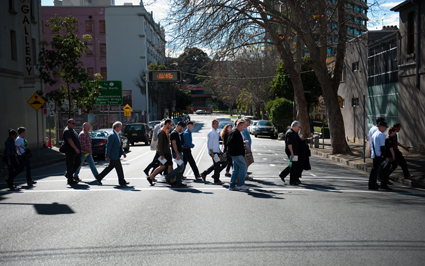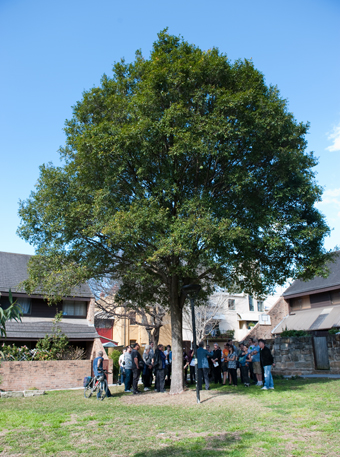when is a walk art?
ian milliss: the green ban art walks, sydney

Green Bans Art Walk
photo Alex Wisser
Green Bans Art Walk
“ICI EST TOMBÉ POUR LA LIBÉRATION…”
It’s not difficult to describe the Green Ban Art Walks. They were a series of walks through Kings Cross and Woolloomooloo on five successive Saturday afternoons in August 2011. Celebrating 40 years since the first Builders Labourers Federation (BLF) bans, which saved much of the area from high-rise, the walks were sponsored by Performance Space and moved from Cross Art Projects down to Big Fag Press in Woolloomooloo.
Each walk began with a talk by a prominent urban activist of the time, while other former activists spoke at buildings, monuments and plaques along the way. In other words it resembled the architectural tourist walk so common around the world, except that many of the speakers had played a crucial part in the historical events that were being discussed. But where is the art part?
There was the obvious conventional historical connection. Victoria Street in particular has a long bohemian history with many artists living there since the late 19th century. In 1973 the hard edge painter Joe Szabo, for instance, lived in the most contested area of the street and organised an exhibition in support of the Green Ban. Other artists were active in the various resident action groups—the weaver Margaret Grafton was secretary of the Darlinghurst group and painter Vicki Varvaressos was an active member; the Victoria Street group’s Mick Fowler was a part-time jazz musician while conceptualist Dave Morrissey, cartoonist Jenny Coopes, author Sasha Soldatow and myself were all active there; Brenda Humble and Toby Zoates were involved at various times in Woolloomooloo.
In the late 1970s a Margel Hinder sculpture became a centrepiece of the Woolloomooloo public housing redevelopment while Michiel Dolk and Merilyn Fairskye led a group of painters, most of whom had lived in the area, in creating a series of murals on the railway pylons through the centre of Woolloomooloo.
The walks themselves were organised by artists, starting at Jo Holder’s Cross Art Projects gallery where prints by Fiona Macdonald based on local Green Ban imagery were part of the display, and terminating in Woolloomooloo at Big Fag Press where artists and walk co-ordinators Diego Bonetti, Lucas Ihlein, Mickie Quick and Pat Armstrong continue the tradition of artist involvement in the Woolloomooloo community.
All of this and more was discussed on the walk, yet somehow that just scratched the surface. It was clear that from its inception the walk itself was to be seen as art—after all it was being sponsored by Performance Space so surely there would be an element of performance in it?
If you regard art making as the process of generating meaning then the walks fitted the bill, almost too well. However, there is a sense in which a walk with meaning is a good walk ruined. We feel we should be able to merely observe and enjoy the scene without interpretation, or at least that’s what an “art for art’s sake” worldview would suggest.

Green Bans Art Walk
photo Alex Wisser
Green Bans Art Walk
But this was not the aimless ramble of the flâneur, not the process of creating a personal map and mythology through exploration, nor was it the purposeful utilitarian walk to get from Point A to Point B. These walks were the process of imposing memory on an urban space, an almost ritualistic march through spaces loaded with historical meanings, even though they may seem to be comparatively esoteric in the eternal sunshine of our present real estate bubble.
And although walks in recent times have developed into an artistic genre of their own— mythogeography—since time immemorial they have been associated with memory, with monuments and the memorialisation of past events and people. The walk along the River Avon from Woodhenge to Stonehenge with the ashes of the year’s dead seems to have been the real reason for Stonehenge, and religious piety was manifested in the Way of St James, the great medieval Christian pilgrimage across most of Europe to Santiago de Compostela in Spain, or the Islamic Hajj that still brings millions to Mecca each year for the ritualistic circumambulation of the Ka’ba. In Australia it could probably be argued the song lines of Aboriginal migration routes memorialise the Dreamtime ancestors, while Anzac Day and May Day marches memorialise different types of political and social struggles.
It seems entirely appropriate that the Green Bans should be celebrated in walks, after all, marches and street demonstrations were so much a part of their process. The Green Ban and resident action group movements were a challenge to the idea that cities are owned by developers, rather than being a form of commons owned by the entire range of inhabitants. The struggle that followed, often an extremely violent struggle, aimed to defend not just the physical fabric and architectural heritage of Sydney but also to ensure a more equitable sharing of the city by all its inhabitants. Walking through Victoria Street, the scene of some of the most violent confrontations, and then down across Woolloomooloo, an area saved for public housing, demonstrated the movement’s range of successes and failures and also the way the movement itself accommodated a wide spectrum of social and class interests.
But finally, inherent in all this is a different understanding of the term “art.” At the time of the Green Bans only the most radical could conceive of art as anything other than individually created paintings and sculptures in galleries. In the 40 years since, our understanding has moved on and we can easily accept these walks as a form of cultural activity equally as legitimate as any painting, even though they are ephemeral events rather than objects, involve galleries only peripherally and are collaborative to the point where there are contributions by dozens of individuals—I have only named a small number of them here.
Yet I think there is another change occurring. Implicit in the art walks is not just the claim that the walks are art, but also that the events they memorialise were art—or at least an important and innovative form of cultural activity. Recognising that a series of events that are conventionally seen as political activism can be also be seen as art, implies that the official art world does not own culture any more than developers own the city.
In fact our culture´s constant process of innovation and adaptation is the work of all of us whether we call ourselves artists or not. It is only by cultural innovation that anyone can earn the title “artist,” and the BLF members’ cultural innovation in defence of a liveable city made them artists, probably the best artists of their era and greater than any of the shallow decorators we see celebrated in art museums.
At this point in human history, the cultural memes we have created, like consumerism and corporate capitalism, are beginning quite literally to destroy us, and probably much other life on the planet. This is exactly what the media tries to obscure with unrelenting propaganda, insisting that we live the best of all possible lives in the best of all possible systems, that any suggestion otherwise is crazy or treacherous. In the face of such propaganda, issues like cultural innovation are suddenly issues of survival. But there can only be change when there is an understanding that there has been change, that things were different in the past and can therefore be different in the future.
If you ignore the official cultural gatekeepers, it becomes clear that much of the time the most influential cultural players, the “artists,” are unrecognisable, anonymous even, and acting in groups, like the BLF members. If we understand that, then we also open a path to future action—they took control of the city once and we can do it again, and we can take control of other things like the media and the museums. By walking through areas they saved, recognising what they did and documenting and celebrating it, we enact a memorial to them but we also enact a memorial to ourselves because it is our city, this is part of the process of re-occupying it. Every last anonymous one of us can fight back against the destructive values of consumption, greed and narcissism that are constantly impressed upon us by the media and the profiteers bent on private control and ownership of what should be a shared world.
If events like the walks can help to keep alive the residents’ and builders labourers’ example of innovation and activism, then we also keep alive the possibility that we too could adapt our cultural memes into less toxic ones. We could help save civilisation simply by remembering that perhaps it can be saved because others also tried to.
“Ici est tombé pour la libération…” This text was commonly found on eye-level white plaques throughout Paris in memory of Resistance members killed there during the final days of the liberation of the city in the Second World War.
Green Bans Art Walk was a WALK project, part of Performance Space’s 2011 season of walks, promenades, marches and strolls in and around Sydney and beyond.
Performance Space, Big Fag Press, Cross Art Projects, First Draft Depot: Green Bans Art Walk, Sydney, Aug 6-27, 2011
RealTime issue #108 April-May 2012 pg. 42






